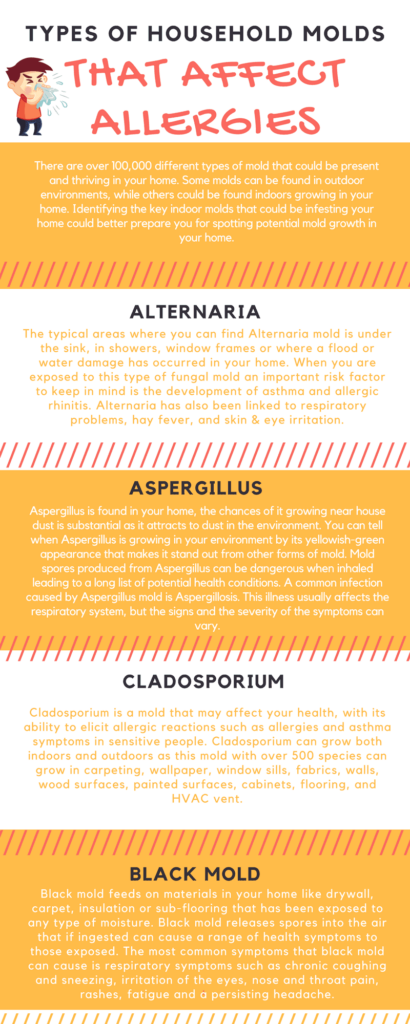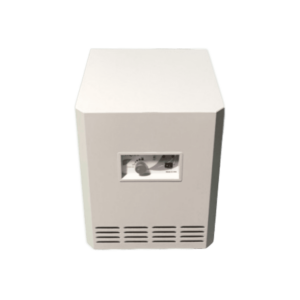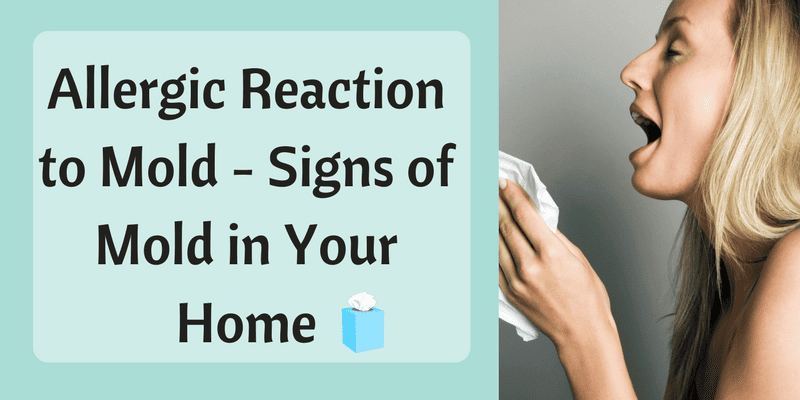[show_product_inpage product_id=9601]
Red stuffy nose, itchy or watery eyes, and a tickle in the back of your throat that just won’t go away. Does that sound similar, maybe even like something you are experiencing right this moment? When you experience these symptoms, the onset of an allergic reaction is probably occurring and boy can it be a nightmare to deal with, and a real pain (sometimes literally!). Every day we are surrounded by allergens in our environment, some that may impact us and our health more severely than others. Our home’s can be a breeding ground for unwarranted allergens as the indoor air collects the allergens found in your home. One of the biggest home allergens that we must combat is the dreaded and hard to expel mold.
 Types of Household Molds That Affect Allergies
Types of Household Molds That Affect Allergies
There are over 100,000 different types of mold that could be present and thriving in your home. Some molds can be found in outdoor environments, while others could be found indoors growing in your home. Identifying the key indoor molds that could be infesting your home could better prepare you for spotting potential mold growth in your home and reduce allergic reaction to mold.
Alternaria
Alternaria mold is a mold that can easily enter homes and finds it perfect shelter in a damp area with moisture to feed off of. The typical areas where you can find Alternaria mold is under the sink, in showers, window frames or where a flood or water damage has occurred in your home. When you are exposed to this type of fungal mold an important risk factor to keep in mind is the development of asthma and allergic rhinitis. Alternaria has also been linked to respiratory problems, hay fever, and skin & eye irritation.
Aspergillus
Commonly found in areas of extreme moisture, Aspergillus is a mold that is located everywhere from outdoor environments to indoor environments. When this mold is found in your home, the chances of it growing near house dust is substantial as it attracts to dust in the environment. You can tell when Aspergillus is growing in your environment by its yellowish-green appearance that makes it stand out from other forms of mold. Mold spores produced from Aspergillus can be dangerous when inhaled leading to a long list of potential health conditions. A common infection caused by Aspergillus mold is Aspergillosis. This illness usually affects the respiratory system, but the signs and the severity of the symptoms can vary.
Cladosporium
Cladosporium is a mold that may affect your health, with its ability to elicit allergic reactions such as allergies and asthma symptoms in sensitive people. Whenever you have had prolonged exposure to this type of mold (like in your home) you may experience even more severe symptoms such as allergy and asthma attacks. Cladosporium can grow both indoors and outdoors as this mold with over 500 species can grow in carpeting, wallpaper, window sills, fabrics, walls, wood surfaces, painted surfaces, cabinets, flooring, and HVAC vent.
Black Mold
Toxic black mold, or also referred to as Stachybotrys Chartarum is a dangerous form of mold that can grow in your home. Black mold feeds on materials in your home like drywall, carpet, insulation or sub-flooring that has been exposed to any type of moisture. Black mold releases spores into the air that if ingested can cause a range of health symptoms to those exposed. The most common symptoms that black mold can cause is respiratory symptoms such as chronic coughing and sneezing, irritation of the eyes, nose and throat pain, rashes, fatigue and a persisting headache.
Mold Sickness – Allergy Signs
Mold sickness is a culmination of health issues that can occur from any potential mold exposure. Typically we associated allergies with exposure to mold, but mold can cause illness without igniting an allergic reaction. Mold can cause infections more severe than most allergy symptoms, as its a state of chronic inflammation caused by the immune system becoming out of whack.
Other signs of mold sickness can include:
- Memory problems
- Fatigue
- Muscle cramping
- Numbness and tingling
- A headache
- Light sensitivity
- Sinus problems
- Vertigo
- Abdominal pain
- Increased urination

Allergy Remedies for Your Home
Allergens can be floating around your home, infesting your air and making your allergies start up in full force. When you have mold growing in your home, the mold will begin to release mold spores into the environment which can be a huge trigger for many people suffering from allergies. Treating your home’s air of mold allergens can be a hard task to complete, as mold spores are so tiny and can hide in the most unsuspecting places. Using an air purifier like the EnviroKlenz Mobile UV System will help to capture and kill microorganisms such as bacteria, viruses, and mold spores in your air utilizing a high efficiency ultraviolet germicidal radiation (UVC lights) to kill these organisms. This air purification system uses a two-stage filtration process with a patented earth mineral air cartridge that removes a broad spectrum of chemicals and odors, as well as a hospital-grade HEPA filter that removes particulate matter up to 0.3 microns in size. With this air purification system, you can say goodbye to mold spores in your air for good.


Hear What People Are Saying About Us…
“Whether you have MCS or just don’t want to breath in toxic or annoying odors, you should check out EnviroKlenz! Their products are a dream come true for anyone who has MCS, Asthma, or are allergic and/or sensitive to perfumes or mold.
Thank you EnviroKlenz for saving my clothing and bedding!!”
I absolutely LOVE my Enviroklenz air purifier. I live in Los Angeles with very poor air quality. In my home I now have peace of mind that my indoor air quality is safe and relish coming home after breathing in toxic air when I’m out. Detox is the top priority in my home and my air purifier helps me to meet my health goals by preventing toxins from entering my body via the air.
Thank you Enviroklenz!








